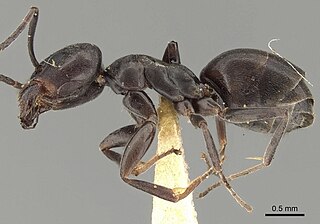
Lasius is a genus of formicine ants. The type species for this genus is the black garden ant, Lasius niger. Other major members, which live in drier heathland, are the cornfield ant, L. neoniger, and L. alienus. Other species include the temporary social parasites of the L. mixtus group and the hyper-social parasite Lasius fuliginosus. Lasius flavus is also a commonly seen species, building grassy hillocks in undisturbed pasture. In the Alps, these mounds – always aligned east to catch the first rays of the rising sun – have been traditionally used by goatherds as natural compasses. Species in the subgenus Acanthomyops, in particular L. interjectus and L. claviger, are commonly known as citronella ants due to their citronella-like smell.

The erratic ant is a species of dolichoderine ant first described in 1789 by Latreille.

Dolichoderinae is a subfamily of ants, which includes species such as the Argentine ant, the erratic ant, the odorous house ant, and the cone ant. The subfamily presents a great diversity of species throughout the world, distributed in different biogeographic realms, from the Palearctic, Nearctic, Afrotropical region and Malaysia, to the Middle East, Australian, and Neotropical regions.

Tapinoma is a genus of ants that belongs to the subfamily Dolichoderinae. The genus currently comprises 74 described species distributed worldwide in tropical and temperate regions. Members of are generalized foragers, nesting in a wide variety of habitats, ranging from grasslands, open fields, woodlands, to inside buildings. The majority of species nest in the ground under objects such as stones or tree logs, other species build nests under bark of logs and stumps, in plant cavities, insect galls or refuse piles.
Tapinoma electrinum is an extinct species of ant in the genus Tapinoma. Described by Dlussky in 2002, fossils of the species were found in the Rovno amber in Ukraine, where a fossilised male of the species was described.
Tapinoma glaesaria is an extinct species of ant in the genus Tapinoma. Originally described by Gennady Dlussky in 2002 as Tapinoma aberrans, fossils of the species were found in the Rovno amber in Ukraine. The original specific name was a secondary homonym of Tapinoma aberrans, an extant species from Madagascar. Perrichot, Salas-Gismondi & Antoine (2019) coined a replacement name T. glaesaria for the taxon described by Dlussky.

Tapinoma annandalei is a species of ant in the genus Tapinoma. Described by William Morton Wheeler in 1928, the species is endemic to India.
Tapinoma demissum is a species of ant in the genus Tapinoma. Described by Bolton in 1995, the species is endemic to Tanzania and Zimbabwe.

Tapinoma emeryi is a species of ant in the genus Tapinoma. Described by Ashmead in 1905, the species is endemic to Tanzania and Philippines.
Tapinoma festae is a species of ant in the genus Tapinoma. Described by Emery in 1925, the species is endemic to Greece, Iran and Turkey.
Tapinoma krakatauae is a species of ant in the genus Tapinoma. Described by William Morton Wheeler in 1924, the species is endemic to Indonesia.
Tapinoma madeirense is a species of ant in the genus Tapinoma. Described by Forel in 1895, the species is endemic to various countries to many countries throughout Europe.

Tapinoma nigerrimum is a species of ant in the genus Tapinoma. Described by Nylander in 1856, the species is endemic to Africa and Europe.
Tapinoma philippinense is a species of ant in the genus Tapinoma. Described by Donisthorpe in 1942, the species is endemic to the Philippines.

Tapinoma simrothi is a species of ant in the genus Tapinoma. Described by Krausse in 1911, the species is endemic to many countries spanning in Africa, Asia and Europe.

Tapinoma wilsoni is a species of ant in the genus Tapinoma. Described by Sharaf and Aldawood in 2012, the species is endemic to Saudi Arabia.

An ant supercolony is an exceptionally large ant colony, consisting of a high number of spatially separated but socially connected nests of a single ant species, spread over a large area without territorial borders. Supercolonies are typically polygynous, containing many egg-laying females. Workers and queens from different nests within the same supercolony can freely move among the nests, and all workers cooperate indiscriminately with each other in collecting food and care of the brood, and show no apparent mutual aggressive behavior.









